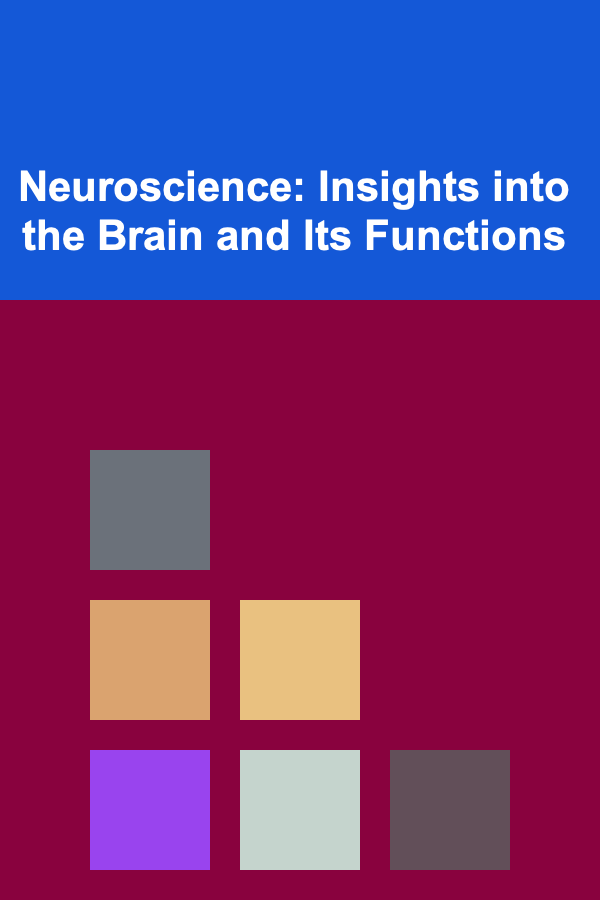
Neuroscience: Insights into the Brain and Its Functions
ebook include PDF & Audio bundle (Micro Guide)
$12.99$6.99
Limited Time Offer! Order within the next:

Neuroscience is a rapidly advancing field of science that explores the complexities of the brain and nervous system. The brain, the control center of our body, is responsible for everything we think, feel, and do. From regulating basic life functions like breathing and heartbeat to enabling complex cognitive processes like reasoning, decision-making, and memory, the brain is the seat of consciousness and behavior. As neuroscience continues to evolve, researchers are gaining deeper insights into how the brain works, how it changes, and how it can be influenced by genetics, environment, and experience.
In this article, we will delve into the core principles of neuroscience, explore the brain's major structures and their functions, and examine the latest research in the field to uncover how the brain shapes our daily lives and our health.
The Brain: An Overview
The human brain is an incredibly complex organ. Weighing about 3 pounds, it contains roughly 86 billion neurons and trillions of synapses, which form the intricate network of connections that enable thought, sensation, movement, and emotion. The brain is divided into several regions, each responsible for specific functions. These regions work in harmony, but the exact ways they communicate and integrate information are still subjects of active research.
Major Brain Regions and Their Functions
-
Cerebrum The cerebrum is the largest part of the brain, divided into two hemispheres (left and right). It is responsible for higher brain functions, including sensory processing, motor control, language, reasoning, and emotions.
- Frontal Lobe: This region is involved in higher cognitive functions such as reasoning, problem-solving, planning, and emotions. It also controls voluntary movement and helps regulate social behavior.
- Parietal Lobe: The parietal lobe processes sensory information, particularly related to touch, temperature, and pain. It also plays a key role in spatial awareness and coordination.
- Occipital Lobe: The occipital lobe is primarily responsible for processing visual information. It interprets signals from the eyes, allowing us to recognize shapes, colors, and movement.
- Temporal Lobe: Located on the sides of the brain, the temporal lobe processes auditory information and is involved in memory formation. It also helps in recognizing faces and objects.
-
Cerebellum The cerebellum, located at the back of the brain, is primarily responsible for coordinating voluntary movement, balance, and motor skills. It ensures that movements are smooth and precise.
-
Brainstem The brainstem is the oldest part of the brain and connects the brain to the spinal cord. It controls basic life-sustaining functions such as heart rate, breathing, and digestion. The brainstem also serves as a pathway for communication between the brain and the rest of the body.
-
Limbic System The limbic system is a group of structures located deep within the brain, which are primarily involved in emotions, memory, and motivation. Key components include the hippocampus (responsible for memory formation), amygdala (emotion regulation), and hypothalamus (which controls hunger, thirst, and sexual behavior).
How Neurons and Synapses Work
The basic functional unit of the brain is the neuron. Neurons are specialized cells that transmit electrical signals throughout the body, allowing for communication between different brain regions and the body. Each neuron consists of a cell body, dendrites (branch-like structures that receive signals), and an axon (a long, thread-like structure that transmits signals).
When a neuron receives a signal, it generates an electrical impulse known as an action potential. This impulse travels down the axon and reaches the synapse, which is the junction between two neurons. At the synapse, the electrical signal is converted into a chemical signal, and neurotransmitters (chemical messengers) are released. These neurotransmitters bind to receptors on the next neuron, continuing the communication process.
Neurotransmitters play a crucial role in how the brain functions. Some common neurotransmitters include:
- Dopamine: Associated with pleasure, reward, and motivation.
- Serotonin: Regulates mood, appetite, and sleep.
- Acetylcholine: Important for learning and memory.
- Glutamate: The primary excitatory neurotransmitter involved in learning and memory.
- GABA: The main inhibitory neurotransmitter that helps regulate neural activity.
The balance of these neurotransmitters is critical for maintaining mental and emotional health. Imbalances can lead to a range of conditions, such as depression, anxiety, and neurological disorders.
The Plasticity of the Brain: How It Changes Over Time
One of the most fascinating aspects of the brain is its ability to change and adapt throughout life. This phenomenon, known as neuroplasticity, refers to the brain's capacity to reorganize itself by forming new neural connections. Neuroplasticity is essential for learning, memory, and recovery from injury.
Types of Neuroplasticity
- Functional Plasticity: This refers to the brain's ability to transfer functions from damaged areas to healthy regions. For example, if one part of the brain is injured (such as after a stroke), other parts may take over the damaged functions to compensate.
- Structural Plasticity: This type of plasticity involves the physical changes in the structure of the brain. When we learn something new or engage in repetitive activities, the brain forms new synaptic connections. This is why cognitive training and skill-building can result in measurable changes in the brain.
Factors That Influence Neuroplasticity
- Experience: The more we practice or experience something, the more likely our brain will form new connections. For instance, learning a new language or playing an instrument can create new pathways in the brain.
- Age: While neuroplasticity is present throughout life, the brain's ability to reorganize and form new connections is greatest in childhood. However, neuroplasticity can still occur in adults, albeit at a slower rate.
- Environment: A stimulating environment with new challenges can promote neuroplasticity. Conversely, a lack of stimulation can limit the brain's growth and development.
- Physical Exercise: Regular physical exercise, particularly aerobic activity, has been shown to promote neurogenesis (the creation of new neurons) in areas of the brain related to memory and learning, such as the hippocampus.
Cognitive Functions: Memory, Learning, and Decision-Making
The brain is responsible for a wide range of cognitive functions, such as memory, learning, attention, and decision-making. These functions are not isolated in a single brain region but rather involve complex networks of neurons working together.
Memory
Memory is one of the brain's most essential functions. There are several types of memory, including:
- Short-Term Memory: This refers to the temporary storage of information, such as remembering a phone number for a few minutes. The prefrontal cortex plays a critical role in short-term memory.
- Long-Term Memory: This involves storing information over an extended period. The hippocampus is particularly important for transferring short-term memories into long-term storage.
- Procedural Memory: This type of memory involves knowing how to do things, like riding a bike or typing. It relies on the basal ganglia, which is involved in motor control and habits.
Memory is influenced by various factors, such as attention, emotional states, and sleep. For instance, sleep plays a crucial role in consolidating memories and promoting learning.
Learning
Learning is a dynamic process that involves the brain's ability to acquire new information and adapt to new situations. It is closely tied to neuroplasticity, as new experiences and information lead to the formation of new neural pathways.
Learning can be broken down into three stages:
- Encoding: The process of acquiring new information and transforming it into a format that can be stored in the brain.
- Consolidation: The stabilization of new memories over time, often occurring during sleep.
- Retrieval: The process of recalling stored information when needed.
Decision-Making
The brain's ability to make decisions is influenced by various regions, such as the prefrontal cortex, which is involved in reasoning, judgment, and impulse control. Decision-making also depends on emotions, as the amygdala processes emotional information that can influence our choices.
The brain uses a cost-benefit analysis when making decisions, weighing the potential rewards and risks. This is heavily influenced by dopamine, the brain's "reward" neurotransmitter, which plays a role in motivation and reinforcement learning.
Mental Health and the Brain
The brain's functions are not always perfect, and mental health disorders can arise when there are imbalances or dysfunctions in the brain. Conditions like depression, anxiety, schizophrenia, and bipolar disorder are associated with changes in brain structure and chemistry.
For example, in depression, researchers have found alterations in the hippocampus, prefrontal cortex, and amygdala. Neurotransmitter imbalances, particularly in serotonin and dopamine, also play a significant role in mood regulation.
Recent advances in neuroscience have led to new treatments for mental health disorders, such as cognitive-behavioral therapy (CBT) , psychedelic therapy, and pharmacological interventions that target specific neurotransmitters.
Conclusion
Neuroscience provides profound insights into the brain's structure, function, and potential for adaptation. The brain is a highly dynamic organ, constantly changing in response to our experiences, behaviors, and environment. Understanding the intricate workings of the brain not only helps us appreciate the complexities of human behavior but also opens up new possibilities for improving mental health and enhancing cognitive abilities. As research continues, we are likely to uncover even more about the brain's remarkable capacity for change, learning, and healing.
Reading More From Our Other Websites
- [Home Budget Decorating 101] How to Use Rugs to Add Warmth and Style on a Budget
- [Star Gazing Tip 101] Essential Gear for Night-Sky Watching: A Starter's Checklist
- [Gardening 101] Micro‑Microgreens: Quick, Nutritious Crops for the Smallest Kitchen Corners
- [Personal Financial Planning 101] How to Master the Art of Money Management in Your 30s
- [Home Renovating 101] How to Remodel Your Home for Aging in Place: Creating a Safe and Accessible Living Space
- [Home Budget 101] How to Budget for Unexpected Home Repairs
- [Needle Felting Tip 101] Creative Needle Sets: Building the Ideal Toolkit for Advanced Needle Felting Techniques
- [Personal Care Tips 101] How to Create Ombre Lips Using Different Lipstick Shades
- [Home Renovating 101] How to Renovate Your Kitchen for a Modern Look
- [Home Budget Decorating 101] How to Make the Most of Cheap Ideas for a Small Space

How To Choose the Right Socks to Complement Your Shoes
Read More
How to Clean Your Bathroom Like a Professional Cleaner
Read More
How to Create a System for Shared Laundry Use
Read More
How to Identify and Fix Noise Problems in Older Homes
Read More
How to Repurpose Holiday Decorations from Previous Years in New Ways
Read More
What DIY Projects Can Help You Organize Your Home Quickly?
Read MoreOther Products

How To Choose the Right Socks to Complement Your Shoes
Read More
How to Clean Your Bathroom Like a Professional Cleaner
Read More
How to Create a System for Shared Laundry Use
Read More
How to Identify and Fix Noise Problems in Older Homes
Read More
How to Repurpose Holiday Decorations from Previous Years in New Ways
Read More